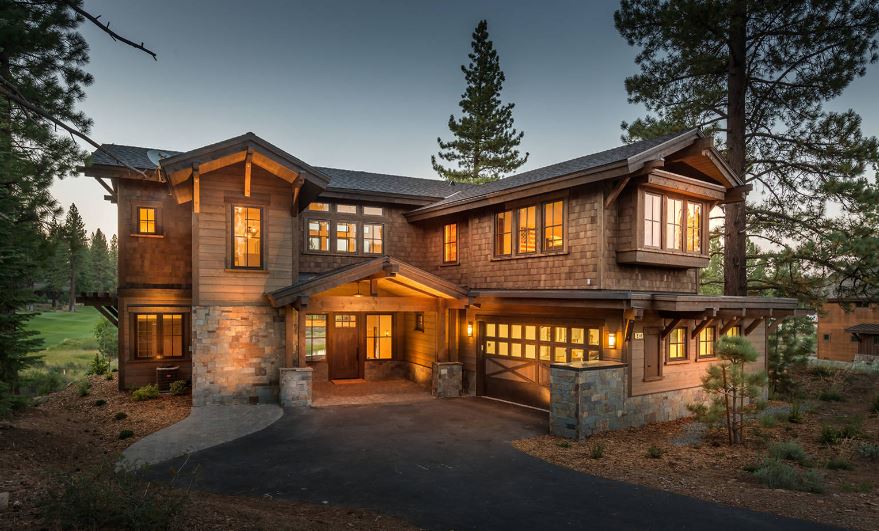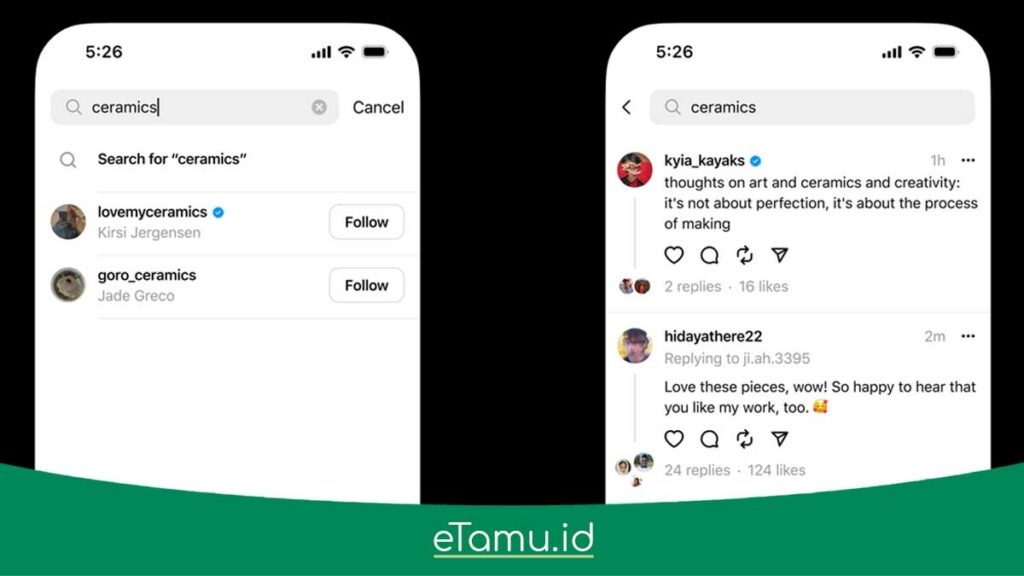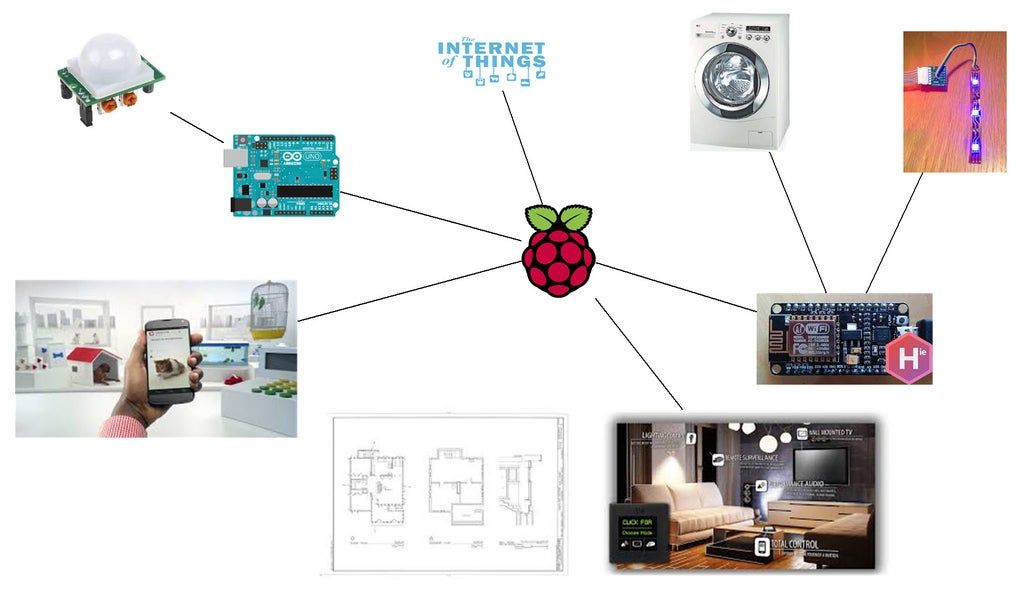Voice-controlled home systems are revolutionizing how we interact with our homes. Imagine effortlessly controlling lights, adjusting the thermostat, or playing your favorite music just by using your voice. This technology has evolved from simple home automation to a sophisticated experience, seamlessly integrating voice interfaces into everyday tasks.
This exploration dives deep into the inner workings of voice-controlled homes, examining the key components, user experience, security concerns, and exciting future trends. We’ll compare different voice assistants, look at the essential hardware, and discuss how to make these systems both user-friendly and secure. Get ready to unlock a smarter, more convenient way to live.
Introduction to Voice-Controlled Homes
Voice-controlled home systems are rapidly changing how we interact with our living spaces. These systems use voice commands to control various aspects of the home, from adjusting lights and temperature to playing music and managing security. This evolution represents a significant shift from traditional home automation methods, offering a more intuitive and user-friendly approach.The journey towards voice-controlled homes has been a gradual one, building upon decades of advancements in home automation.
Early systems relied on complex setups of switches and remote controls. Later, home automation systems introduced programmable controllers and smart hubs, allowing for more sophisticated control. Voice control, with its intuitive nature, has emerged as the latest and most user-friendly stage in this evolution.
Core Concepts of Voice Interfaces
Voice interfaces are the bridge between human language and the actions performed by home automation systems. They rely on sophisticated speech recognition technology to convert spoken commands into actionable instructions. These interfaces also employ natural language processing (NLP) to understand the nuances and context of the user’s requests. The result is a seamless and intuitive interaction that simplifies tasks and makes home automation more accessible.
This technology allows users to control devices and services without needing to use physical controls.
Voice Assistants in Home Automation
Voice assistants play a central role in modern voice-controlled homes. They act as the intermediary between the user’s voice commands and the devices they wish to control. Understanding their diverse capabilities is crucial to selecting the right system for a home.
| Voice Assistant | Key Features | Strengths | Weaknesses |
|---|---|---|---|
| Amazon Alexa | Multi-room audio, smart home integration, extensive skill library, compatibility with numerous devices | Wide device compatibility, vast skill library, comprehensive ecosystem, user-friendly interface | Privacy concerns regarding data collection, limited customization options compared to some competitors |
| Google Assistant | Integration with Google services, seamless control of Google Home devices, natural language understanding | Strong integration with Google ecosystem, natural language processing capabilities, voice search integration | Fewer third-party device integrations compared to Alexa, potentially less extensive skill library |
| Apple Siri | Integration with Apple devices, seamless control of Apple HomeKit devices, voice-activated control | Strong integration with Apple ecosystem, high level of security, seamless transition between devices | Limited device compatibility outside of the Apple ecosystem, potentially less extensive skill library than Alexa |
Key Components of a Voice-Controlled Home
Voice-controlled homes are rapidly becoming more commonplace, offering convenience and automation. Understanding the key components behind this technology is essential for appreciating its capabilities. These systems rely on a network of interconnected devices that work together seamlessly to respond to voice commands.A sophisticated voice-controlled home isn’t just about individual smart devices; it’s about a sophisticated network where each component plays a vital role.
Voice-controlled homes are becoming increasingly popular, especially in modern luxury lifestyle houses. These homes often incorporate smart features like automated lighting, temperature control, and entertainment systems. A great example of this is a Luxury lifestyle house that seamlessly integrates voice commands into the everyday experience, making home management incredibly convenient and efficient. Ultimately, voice-controlled technology elevates the home experience, making life easier for the occupants.
The interaction between these elements allows for a unified and intuitive experience. From simple tasks like adjusting the thermostat to complex scenarios like activating security protocols, voice control streamlines home management.
Hardware Components, Voice-controlled home
The foundation of any voice-controlled home lies in its hardware components. These devices, often hidden from view, form the backbone of the system. Essential components include the voice assistant device, smart appliances, and communication protocols.
Voice Assistant Device
The voice assistant device is the central hub of the system. It acts as the intermediary between the user’s voice commands and the smart devices within the home. This device, often a smart speaker or a dedicated voice assistant, listens for commands, interprets them, and then sends instructions to the appropriate smart devices. Examples include Amazon Echo, Google Nest, and Apple HomePod.
Voice-controlled homes are becoming increasingly popular, and they’re a great way to make your life easier. Imagine living in a sleek, modern coastal home like Coastal modern house , where you can control everything from the lights to the thermostat with just your voice. It’s a really convenient feature, especially if you’re busy or have a hectic schedule.
Smart Appliances and Devices
Smart appliances and devices are the “muscle” of the voice-controlled home. These devices are programmed to respond to commands from the voice assistant. They range from smart lighting and thermostats to smart locks and security systems. Each device possesses its own unique set of functionalities.
Communication Protocols
The smooth operation of a voice-controlled home relies on robust communication protocols. These protocols dictate how information is exchanged between the voice assistant device and the various smart devices. Common protocols include Wi-Fi, Bluetooth, and Z-Wave, each with its own strengths and weaknesses in terms of range, reliability, and security.
Voice-controlled homes are super convenient, but a key part of making them feel truly at home is the overall aesthetic. A clean aesthetic house, like the ones featured on Clean aesthetic house , really helps the technology blend seamlessly. This attention to detail is crucial for creating a truly relaxing and enjoyable atmosphere in a voice-controlled home.
Table of Smart Home Devices
| Device Type | Example | Functionality |
|---|---|---|
| Lighting | Smart bulbs (e.g., Philips Hue) | Turn lights on/off, adjust brightness, create schedules, and potentially change color. |
| Security | Smart locks (e.g., August, Schlage) | Unlock/lock doors, monitor activity, and potentially receive alerts or control access remotely. |
| Entertainment | Smart speakers (e.g., Amazon Echo, Google Nest) | Play music, podcasts, answer questions, and control other smart devices within the home. |
| Thermostats | Smart thermostats (e.g., Nest, Ecobee) | Adjust temperature settings, schedule heating and cooling, and potentially learn user preferences for optimal comfort. |
| Appliances | Smart refrigerators, ovens, and washing machines | Control various functions of appliances, monitor usage, and receive alerts for maintenance. |
Security and Privacy Concerns
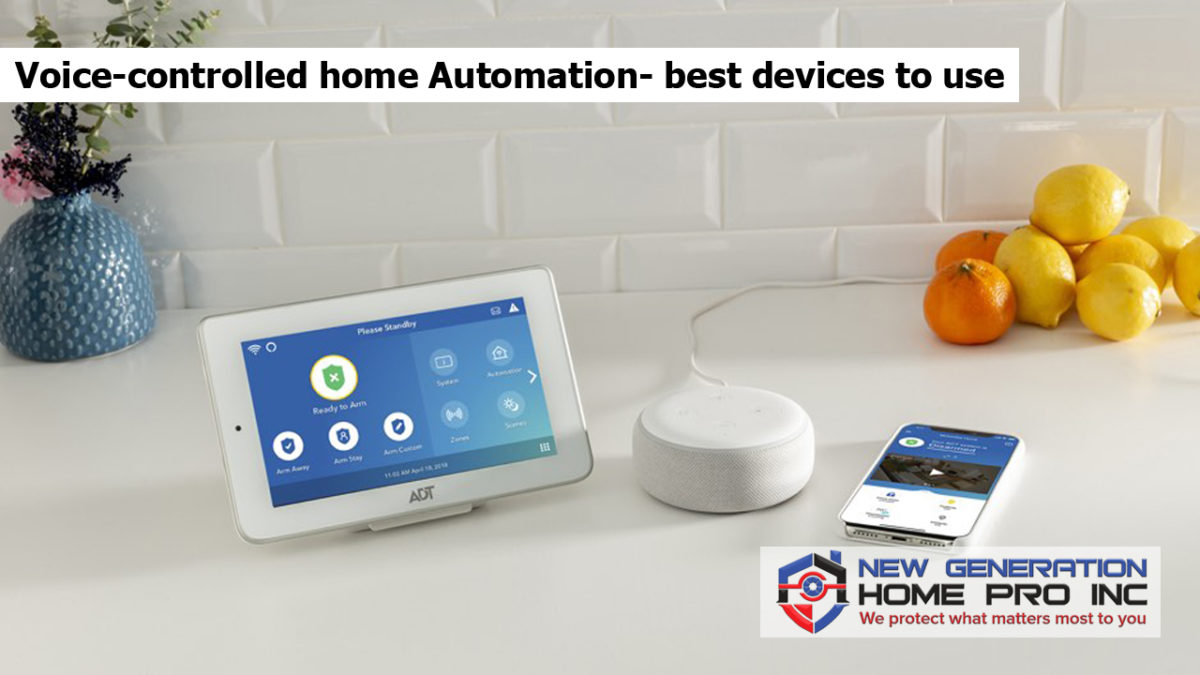
Source: newgenerationhomepro.com
Voice-controlled homes are becoming increasingly popular, offering a convenient way to control various aspects of your living space. The sleek, modern design often incorporates interesting textured finishes, like those found in Textured finishes , which add a unique touch and visual appeal. Ultimately, these features contribute to a more sophisticated and user-friendly smart home experience.
Voice-controlled home systems, while offering convenience, introduce unique security and privacy challenges. Users need to be aware of these potential vulnerabilities to ensure their personal information and home are protected. These systems collect and process a significant amount of data, making them attractive targets for malicious actors.Protecting your voice-controlled home system requires a proactive approach. Understanding the potential risks and implementing robust security measures are crucial.
Security Vulnerabilities of Voice-Controlled Systems
Voice-controlled home systems are susceptible to various security vulnerabilities. These systems often rely on cloud-based servers for processing commands and storing user data. Compromising these servers can expose user information and allow unauthorized access to the home’s systems. Furthermore, weak passwords, insecure Wi-Fi networks, and outdated software can create entry points for hackers. Malicious actors can potentially use vulnerabilities in the system to gain control of home appliances, leading to unwanted actions or even physical damage.
The reliance on a single point of failure (the cloud server) makes the entire system vulnerable.
Voice-controlled homes are becoming increasingly popular, offering a convenient way to manage your living space. Imagine relaxing on the beach, controlling the lights and music in your modern beach house, like the ones featured in this stunning collection Modern beach house. These smart home systems can also easily adjust the temperature and other settings, making everyday life more comfortable and streamlined.
Importance of Data Encryption and Privacy Protocols
Robust encryption is paramount for protecting user data transmitted between the device and the cloud server. Data encryption scrambles the data, making it unreadable to unauthorized individuals. Implementing end-to-end encryption ensures that only the intended recipient can access the data. Furthermore, strict privacy protocols should be in place to limit the collection and usage of user data.
These protocols should clearly Artikel how data is collected, stored, and used. Users should be informed about the data collected and have the option to opt-out of certain data collection practices.
Potential Risks of Unauthorized Access
Unauthorized access to a voice-controlled home system can lead to various risks. Malicious actors could potentially gain control of smart locks, thermostats, and security cameras, potentially compromising the safety and security of the home and its occupants. They could also access sensitive personal data, including voice recordings, activity logs, and financial information. This data breach could result in identity theft, financial losses, and reputational damage.
Furthermore, unauthorized access could be used to manipulate home appliances for malicious purposes, leading to inconvenience or physical harm.
Methods for Improving Security of Voice-Controlled Home Systems
Several methods can enhance the security of voice-controlled home systems. Strong passwords, ideally using a password manager, are essential. Multi-factor authentication adds another layer of security, requiring users to verify their identity through multiple means, such as a code sent to a mobile phone. Regular software updates ensure the system has the latest security patches to address vulnerabilities.
Using a secure Wi-Fi network with strong encryption is crucial. Users should also be cautious about the devices they connect to their home network, as a compromised device could expose the entire system. Reviewing and understanding the privacy policies of the voice-controlled system and its associated services is critical.
Security and Privacy Considerations for Voice-Controlled Homes
| Issue | Description | Mitigation |
|---|---|---|
| Data Breaches | Unauthorized access to personal data, voice recordings, and activity logs. | Robust encryption, multi-factor authentication, regular software updates. |
| Unauthorized Access | Malicious actors gaining control of smart devices, leading to manipulation or damage. | Strong passwords, secure Wi-Fi, multi-factor authentication, regular security audits. |
| Privacy Concerns | Unnecessary collection and use of personal data. | Clear privacy policies, user control over data collection, and data minimization. |
Future Trends and Innovations
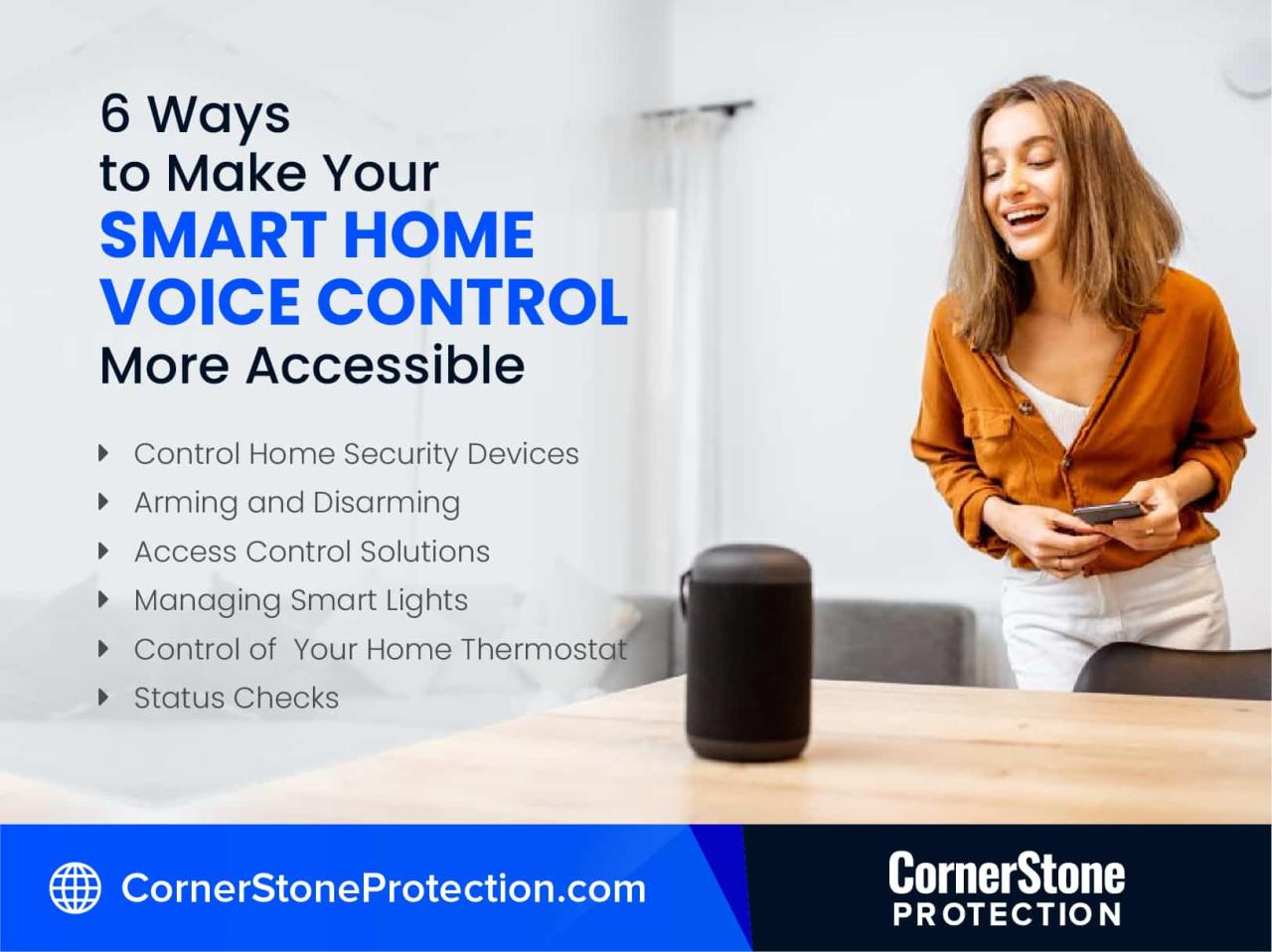
Source: cornerstoneprotection.com
Voice-controlled home systems are rapidly evolving, driven by advancements in artificial intelligence (AI) and other technologies. This evolution promises a more intuitive and personalized experience for users, integrating seamlessly with existing smart home components and even expanding into new areas of our lives. The future of voice control in smart homes is exciting, and innovation is continually pushing boundaries.The integration of AI is key to the future of voice control.
AI allows systems to learn user preferences, adapt to changing routines, and even anticipate needs. This personalized approach elevates voice control beyond simple commands, enabling more sophisticated and responsive interactions.
Emerging Technologies
Voice control is no longer confined to simple commands. The incorporation of machine learning algorithms allows voice assistants to learn from user interactions, making them more accurate and context-aware. This allows for more nuanced commands and anticipates user needs, for example, adjusting the thermostat based on past temperature preferences or automatically ordering groceries when supplies are low. Natural language processing (NLP) is also crucial, allowing for more complex and conversational interactions.
This means voice control can handle more ambiguous or nuanced requests, such as setting a reminder for “when I get home.”
Future Directions
Future voice control systems will likely move beyond basic commands to more proactive and predictive functionality. Imagine a system that automatically adjusts lighting and temperature based on the time of day and user’s predicted schedule. Integration with other smart home devices will be crucial for a more comprehensive experience, potentially including appliances, security systems, and even entertainment devices.
Potential Integration with Other Technologies
The integration of voice control with other technologies is a key future direction. For instance, voice control could be seamlessly integrated with augmented reality (AR) experiences, allowing users to virtually interact with their home environment and control elements through voice commands. Similarly, voice control could become a key component of the metaverse, allowing users to interact with digital environments and control aspects of their virtual spaces using voice commands.
Examples of Emerging Voice-Control Features
AI-powered personalization is a significant advancement. Imagine voice assistants learning your preferences and adapting to your lifestyle. This could involve personalized lighting schedules, music recommendations tailored to your mood, or even adjusting the thermostat based on your past preferences. Predictive features are also on the horizon. For example, a voice-controlled system might anticipate your need for a certain item and place an order before you even realize you’re out.
Comparison of Voice Control Technologies
| Technology | Description | Potential Applications |
|---|---|---|
| AI-powered personalization | Voice assistants learn user preferences and routines to adapt and anticipate needs. | Personalized lighting schedules, music recommendations, automatically adjusting thermostat settings based on past behavior. |
| Natural Language Processing (NLP) | Allows for more complex and conversational interactions, understanding nuanced requests. | Handling ambiguous or detailed requests, such as “set a reminder for when I get home.” |
| Predictive features | Anticipating user needs and actions based on past behavior and context. | Ordering groceries automatically when supplies are low, adjusting lighting and temperature based on predicted schedule. |
Final Conclusion: Voice-controlled Home
In conclusion, voice-controlled homes offer a compelling blend of convenience and control. While security and privacy remain crucial considerations, ongoing advancements in technology and design promise even more seamless integration and personalized experiences in the future. We’ve explored the evolution of home automation, the core concepts, and the potential risks and rewards. Ultimately, voice-controlled homes are shaping a new era of home technology.
Query Resolution
How much does a voice-controlled home system cost?
The cost varies significantly depending on the complexity of the system and the devices you choose. Basic setups can be relatively affordable, while more extensive systems with advanced features and multiple devices can become quite expensive.
What are the common privacy concerns associated with voice-controlled homes?
Privacy is a significant concern, as voice assistants record and process conversations. Data security and encryption are crucial, and users should be aware of the potential risks of unauthorized access.
Can voice-controlled homes be integrated with existing home systems?
Many voice-controlled systems can be integrated with existing smart home setups and even legacy systems, although compatibility can vary. Check the system’s compatibility with your current devices and systems before installation.
What are some troubleshooting tips for voice control issues?
Common issues include poor voice recognition, connectivity problems, and conflicts with other devices. Try checking your internet connection, ensuring the voice assistant is properly connected to the home network, and confirming the device is properly paired and updated.
- AGC Glass A Global Leader in Glass Manufacturing - June 2, 2025
- Voice-controlled home Smart living simplified - May 6, 2025
- Smart Thermostat House Your Eco-Friendly Home - May 6, 2025




